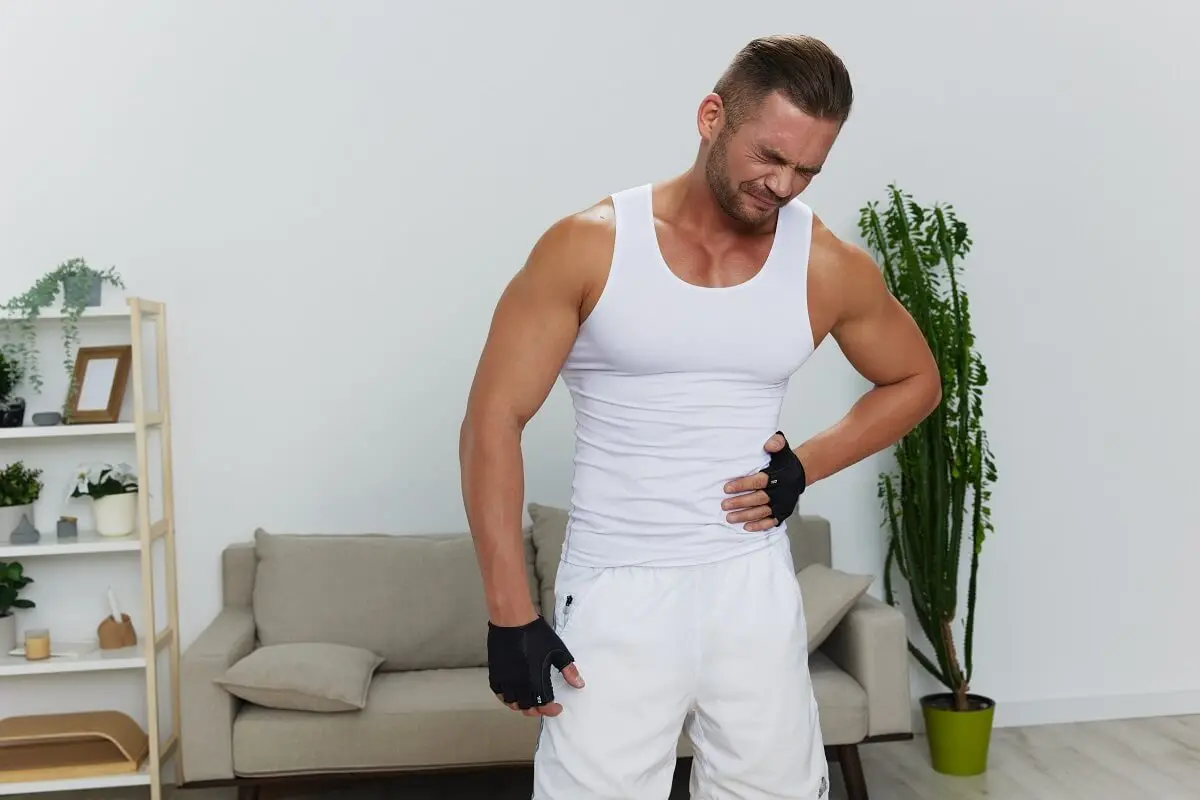What Is an Intercostal Muscle Strain and How Is It Treated?


Reviewed and approved by the doctor Mariel Mendoza
An intercostal muscle strain is an ailment that manifests itself in the muscles between the ribs. It can be caused by overexertion, blow or bad posture. The intensity of the pain varies according to the severity of the injury. However, it tends to worsen when coughing or sneezing.
Treatment is usually based on painkillers, hot and cold compresses, as well as physical therapy. Although they are not usually serious, it is necessary to pay attention to them to avoid further complications. How to recognize this injury? When to see a doctor?
What is an intercostal muscle strain?
Intercostal muscles are those that are found between the ribs, joining them and forming the thoracic wall. They consist of three layers, called the external, internal and innermost intercostals.
During breathing, these muscles contract to help expand the chest and allow the lungs to fill with air. They also provide stability to the upper body.
In a muscle strain, there is a partial or complete tearing of the fibers, which may retract, causing a gap to appear between the fibers. Other structures can also be affected, such as the myotendinous junction (between the muscle and the tendon), tendons and even blood vessels.
So, it is called “intercostal muscle strain” that occurs when the musculature between the ribs is affected by over-tightening or overstretching, causing pain and shortness of breath.

You may also be interested in: 7 Exercises and Stretches for Endometriosis Pain Relief
Symptoms of intercostal muscle strain
In this condition, the main symptom is a sharp pain in the ribs, which can occur on either the right or left side of the chest, due to compression of the nerves of the rib cage. Sometimes it spreads to the back, shoulder or arm.
There is also tenderness in the chest or ribs when touched, as well as muscle spasms. The pain may be sharp and sudden, or at other times, gradual and constant. It worsens when the person bends over, coughs, sneezes, takes a deep breath or makes certain arm movements.
Other symptoms may differ somewhat, depending on the cause. The following may occur:
- Swelling around the ribs
- Stiffness
- Tension
- Difficulty moving the upper limbs
- Difficulty breathing
Possible Causes
As mentioned, this type of strain occurs when the intercostal muscles become too tight. This can occur for a variety of reasons, such as:
- Twisting or excessive twisting.
- Stretching when projecting the arm upward.
- Lifting heavy objects above the shoulders or head.
- Poor body posture.
- Repetitive motion.
- Overexertion.
- A blow or trauma.
- Strong colds with violent sneezing.
- Increased intensity of physical activity.
In turn, certain activities may contribute to the appearance of this injury. For example, cutting firewood, painting upwards and others that are performed with the arm raised for a long time. It also occurs frequently in the practice of some sports; for example, the following:
- Tennis.
- Golf.
- Rowing.
- Basketball.
- Weight lifting.
These involve sudden twisting, force and extension movements. Others, such as boxing, martial arts, and field hockey also pose risks.
Notably, a 2012 investigation notes that it is prevalent in baseball, whether batting or pitching. It is claimed that this ailment accounts for 5% of all injuries in the Major Leagues.
Meanwhile, cases have been identified in which intercostal muscle strain occurs after the insertion of a drainage tube in patients with pleural disease. This often causes pain and spasm.
Another study states that when the person is at high altitude (e.g., when mountaineering), there is irritation and dryness of the airways, with postnasal drip, bronchospasm, and coughing, which in turn can cause intercostal muscle strain and chest wall pain.
Another great article for you: All About Anxiety Chest Pain
What does the diagnosis look like?
When several of the above symptoms are present -especially if the pain becomes persistent, worsens, and interferes with daily activities and rest- it is advisable to see a doctor to make the diagnosis and rule out another type of problem, such as pneumonia.
This involves a physical examination, which will observe if there is limitation of movement, where and when there is more pain. The health professional should also ask about the patient’s occupation, whether there has been a recent accident or sports-related injury.
A chest x-ray or MRI may be ordered to look for rib fractures or internal injuries, such as to the lungs; a spirometer may also be used to determine breathing volume and lung capacity.
However, depending on the symptoms and their intensity, there are various degrees of intercostal muscle strain:
- I or mild: this is a mild strain; some muscle fibers may have torn (less than 5%), loss of movement and strength is little. It may improve in a few weeks, with some care.
- II or moderate: there is more damage to the muscle fibers, swelling and chest pain is present. Therefore, movement is more affected.
- III or severe: severe tear, which may require surgery.
Treatment of intercostal muscle strain
Urgent medical attention is required when intercostal muscle strain is the result of a traumatic injury (e.g. a car accident) and there is shortness of breath.
In general, treatment is aimed at restoring mobility and relieving symptoms such as pain. For these purposes, and depending on the severity, there are different treatment options, as we will see below.
Rest and analgesics
The first thing recommended is to rest the affected part and suspend the activity considered to have caused the injury.
In turn, the physician may recommend the use of over-the-counter analgesics and anti-inflammatory drugs, such as ibuprofen, naproxen or paracetamol. In cases of very severe pain, lidocaine injection or corticosteroids may be given.
Physical therapy
There are also stretches that can help in the recovery process, as long as they are performed by a physical therapy professional. However, if these movements worsen the pain, they should be stopped immediately.
In this regard, a 2017 research mentions a series of thoracic lifting exercises, which were applied in a patient with kyphosis, who presented intercostal muscle pain, which proved effective.

Home care
In addition to the aforementioned rest, with the doctor’s authorization some home care can be maintained, especially if the strain and symptoms are mild. This includes actions such as:
- Use of hot and cold compresses.
- A warm water bath with Epsom salts.
- Breathing exercises, holding a pillow against the chest, inhaling and exhaling slowly and deeply.
Can intercostal muscle strain be prevented?
Occasionally, intercostal muscle strain is the result of sudden twisting, overexertion or repetitive activity. In these cases it can be prevented; but not when it has happened because of a blow.
Now, in order to minimize the risks of suffering this or any other injury, it is necessary to avoid raising the level of intensity of the activity abruptly. And it is always advisable to warm up before exercising, playing sports, even if you are going to do heavy work.
This is something we often overlook. Not only because we are not in the habit of warming up, but also because we forget to stretch the back muscles, which are usually relatively immobile.
Finally, as other preventive measures, we should try to maintain good posture when standing or sitting down to work, watch TV or use the telephone; and get up to stretch our back every so often.
All cited sources were thoroughly reviewed by our team to ensure their quality, reliability, currency, and validity. The bibliography of this article was considered reliable and of academic or scientific accuracy.
- Ayloo, A., Cvengros, T., & Marella, S. (2013). Evaluation and treatment of musculoskeletal chest pain. Primary Care: Clinics in Office Practice, 40(4), 863-887, viii. https://www.primarycare.theclinics.com/article/S0095-4543(13)00088-2/fulltext
- Campagne, D. ( 2023). Overview of Sprains and Other Soft-Tissue Injuries. Merck Manual. https://www.merckmanuals.com/home/injuries-and-poisoning/sprains-and-other-soft-tissue-injuries/overview-of-sprains-and-other-soft-tissue-injuries
- Gundersen, A., Borgstrom, H., & McInnis, K. (2021). Trunk Injuries in Athletes. Current Sports Medicine Reports, 20(3), 150-156. https://journals.lww.com/acsm-csmr/fulltext/2021/03000/trunk_injuries_in_athletes.7.aspx
- Harvard Health Publishing. ( 2023). Muscle strain. Harvard Medical School. Consultado el 28 de mayo de 2024. https://www.health.harvard.edu/a_to_z/muscle-strain-a-to-z
- Pacheco, D., & Rehman, A. (2023). Rest and Recovery: How to Sleep With Intercostal Muscle Strain. Sleep Foundation. Consultado el 28 de mayo de 2024. https://www.sleepfoundation.org/physical-health/how-to-sleep-with-intercostal-muscle-strain
- Litch, J., & Tuggy, M. (1998). Cough induced stress fracture and arthropathy of the ribs at extreme altitude. International Journal of Sports Medicine, 19(3), 220-222. https://www.thieme-connect.com/products/ejournals/abstract/10.1055/s-2007-971908
- Sabherwal, P., Sahasrabudhe, P., Shyam, A., & Sancheti, P. (2021). Immediate effect of proprioceptive neuromuscular facilitation on chest mobility, pain and range of motion of thorax in patients of intercostal drainage: a randomized control trial. The Indian Journal of Chest Diseases and Allied Sciences, 631(6), 131-135. https://vpci.org.in/uploads/VPCI%20Journal%20Jul-Sep%202021%20OA%202.pdf
- Tang, A., & Bordoni, B. (2022). Anatomy, Thorax, Muscles. StatPearls Publishing. Consultado el 28 de mayo de 2024. https://www.ncbi.nlm.nih.gov/books/NBK538321/
- Varada, S. L., Popkin, C. A., Hecht, E. M., Ahmad, C. S., Levine, W. N., Brown, M., & Wong, T. T. (2021). Athletic Injuries of the Thoracic Cage. RadioGraphics, 41(2), E20-E39. https://pubs.rsna.org/doi/full/10.1148/rg.2021200105
This text is provided for informational purposes only and does not replace consultation with a professional. If in doubt, consult your specialist.








